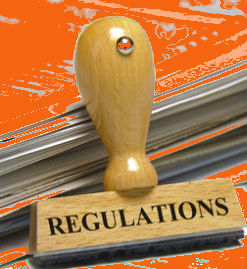by | ARTICLES, BLOG, BUSINESS, ECONOMY, FREEDOM, GOVERNMENT, POLITICS, TAXES

In 2015, the federal government’s published 82,036 pages of rules, proposed rules and notices. It surpassed last year’s 77,687 pages broke the previous record of 81,405 pages in 2010. Competitive Enterprise Institute issued their yearly survey of the federal regulatory state. Among them are some of their findings:
*3,378 final rules and regulations were created
*2,334 proposed rules were issued in 2015 and are at various stages of consideration.
*29 executive orders and 31 executive memorandums were issued
Regulation functions as a hidden tax. Last year’s report calculated that, “based on the best available federal government data, past reports, and contemporary studies, regulatory compliance costs $1.88 trillion annually.”
Recommendations for reigning in regulation include repealing “certain statutes, require congressional approval for big rules and enforce maximum requirements set forth in the Administrative Procedure Act.” 2015 saw major final rules from the EPA — the Clean Power Plan and its Waters of the Unites States rule — as well as the FCC’s net neutrality order.
You can follow updates on federal regulation on CEI’s “Ten Thousand Commandments” page here
by | ARTICLES, BLOG, FREEDOM, GOVERNMENT, OBAMA, POLITICS, TAXES

Last month, Hillary Clinton revealed an idiotic idea in her tax plax that would yet again target American businesses. Clinton proposed creating an “exit tax” for companies that might try to merge with another foreign company. While that concept is ridiculous enough in and of itself, the writers at the Wall Street Journal, Richard Rubin and Lauren Meckler, were just as ridiculous.
Where in the article do they discuss the fact that we have the highest corporate tax rate in the world at 35%? And where do they discuss the fact that we are the only major country in the world that taxes companies both on their domestic and foreign earnings? Nowhere.
In the present environment, U.S. companies face enormous tax obstacles compared to foreign companies. The United States government lays claim to foreign-earned income and also forces them to pay higher tax rates than other foreign companies on the income they make in foreign countries — putting American companies at a severe disadvantage in the global economy.
We’ve created a system that tempts companies to move their HQ abroad or merge with other foreign companies in order to stay solvent and competitive, and now we want to threaten companies or erect more impediments to stop more American businesses from leaving our country? We should be incentivizing them to remain in the United States by lowering the corporate tax rate or remove the tax on foreign earnings! Our tax code and tax rates are simply not competitive anymore.
But Hillary Clinton doesn’t think that. And clearly, neither do the journalists at the WSJ. This article is just dripping with the suggestion that somehow, these companies OWE the government even more of their hard-earned money and/or are not legally or ethically paying their fair share. For instance: “The U.S. taxes companies on their world-wide earnings but allows them to claim foreign tax credits for profits earned abroad and defer U.S. taxes until they bring the money home. That system and the 35% marginal corporate tax rate encourage companies to earn money abroad in low-tax countries and leave it there. U.S. companies now have more than $2 trillion in stockpiled offshore profits that haven’t been fully taxed.” See the word choices? They set up the idea that companies are somehow acting underhandedly.
If that isn’t enough, look how the authors label the Tax Policy Center: “non-partisan.” Now, anyone even remotely interested in economics knows that the Tax Policy Center is decidedly left-leaning. To state otherwise and label it “non-partisan” is at best, naive, and at worst, duplicitous.
Let’s look at some more: “Clinton’s tax would apply to some transactions structured as foreign takeovers of U.S. companies aimed at getting around the rules.” No businesses are “getting around the rules!” Both foreign mergers and inversion are perfectly legal; there’s no loophole or deceptiveness in such business transactions. The only “rules” that businesses are “getting around” are the actual corporate tax laws that make doing business in America on a global scale so insufferable and unjust.
And finally: “The big attraction for companies has been accumulating future profits outside the U.S. tax net.” The US tax net is already enormous! The tax code is so discriminatory against our own American businesses, it makes it harder for our companies to compete and survive and thrive on an international basis. Yet Clinton wants to widen the net further with new taxes and put an even greater stranglehold on companies.
Businesses seek to sell a product and be competitive, not to comply with a draconian, exorbitant tax code. Businesses and investment capital are fleeing the United States in droves and the solution by Hillary Clinton is to tax them further. The fact that this obtuse proposal was backed and perpetuated by these writers at the Wall Street Journal is shameful.
by | ARTICLES, BLOG, ECONOMY, NEW YORK, OBAMA, POLITICS, TAXES

Recently, Gene Epstein of Barron’s made a fascinating observation about Paul Krugman, the New York Times’ darling of economics. On December 18th in the NYTimes, Krugman wrote about the film, “The Big Short”, which was about the “housing bubbles and retold lies.” In his article, Krugman stated that the housing bubble “was largely inflated via opaque financial schemes that in many cases amounted to outfight fraud.”
Unfortunately for Krugman, some folks like Gene Epstein have long memories and short tolerance. Epstein noted that, “This causal analysis is directly contradicted by an alternative view previously expressed in the New York Times: that the housing bubble was largely inflated by policies of the Federal Reserve.
First, Epstein went back to August 2, 2002, when a columnist in the pages of the New York Times, wrote that, “To fight this recession, the Fed needs more than a snapback; it needs soaring household spending to offset moribund business investment. And to do that, as Paul McCulley of Pimco put it, Alan Greenspan needs to create a housing bubble to replace the Nasdaq bubble.”
Nearly seven years later on June 17, 2009, a few months after the crisis of 2008, the same columnist wrote for the New York Times that “What I said was that the only way the Fed could get traction would be if it could inflate a housing bubble. And that’s just what happened.”
Can anyone guess who this columnist is? Gene Epstein knew: Paul Krugman.
Of course, Krugman is counting on his readers to be either a) financial morons like he is; b) short on memory; or c) both. This kind of incompetency from Mr. Krugman is a consummate example of why he should not be the time of day on economic matters.
by | ARTICLES, BLOG, ELECTIONS, FREEDOM, GOVERNMENT, HYPOCRISY, OBAMA, POLITICS, TAXES

In a stunning report issued today by the Wall Street Journal, it was revealed that Obama has continued to spy on certain international allies even after pledging not to more than two years ago. The Wall Street Journal “conducted interviews with more than two dozen current and former U.S. intelligence officials. Government officials representing Israel, Germany and France all declined to comment to the Journal. The Office of the Director of National Intelligence and the NSA also declined.”
While conducting the surveillance, “the National Security Agency’s targeting of Israeli leaders and officials also swept up the contents of some of their private conversations with U.S. lawmakers and American-Jewish groups.”
What’s more, the White House wished avoid both political risk and a permanent record on the matter, and ceded their authority to the NSA to achieve those ends. “White House officials believed the intercepted information could be valuable to counter Mr. Netanyahu’s campaign. They also recognized that asking for it was politically risky. So, wary of a paper trail stemming from a request, the White House let the NSA decide what to share and what to withhold.”
The entire report is worthwhile to read in its entirety. I have reprinted it below:
President Barack Obama announced two years ago he would curtail eavesdropping on friendly heads of state after the world learned the reach of long-secret U.S. surveillance programs.
But behind the scenes, the White House decided to keep certain allies under close watch, current and former U.S. officials said. Topping the list was Israeli Prime Minister Benjamin Netanyahu.
The U.S., pursuing a nuclear arms agreement with Iran at the time, captured communications between Mr. Netanyahu and his aides that inflamed mistrust between the two countries and planted a political minefield at home when Mr. Netanyahu later took his campaign against the deal to Capitol Hill.
The National Security Agency’s targeting of Israeli leaders and officials also swept up the contents of some of their private conversations with U.S. lawmakers and American-Jewish groups. That raised fears—an “Oh-s— moment,” one senior U.S. official said—that the executive branch would be accused of spying on Congress.
White House officials believed the intercepted information could be valuable to counter Mr. Netanyahu’s campaign. They also recognized that asking for it was politically risky. So, wary of a paper trail stemming from a request, the White House let the NSA decide what to share and what to withhold, officials said. “We didn’t say, ‘Do it,’ ” a senior U.S. official said. “We didn’t say, ‘Don’t do it.’ ”
Stepped-up NSA eavesdropping revealed to the White House how Mr. Netanyahu and his advisers had leaked details of the U.S.-Iran negotiations—learned through Israeli spying operations—to undermine the talks; coordinated talking points with Jewish-American groups against the deal; and asked undecided lawmakers what it would take to win their votes, according to current and former officials familiar with the intercepts.
Before former NSA contractor Edward Snowden exposed much of the agency’s spying operations in 2013, there was little worry in the administration about the monitoring of friendly heads of state because it was such a closely held secret. After the revelations and a White House review, Mr. Obama announced in a January 2014 speech he would curb such eavesdropping.
In closed-door debate, the Obama administration weighed which allied leaders belonged on a so-called protected list, shielding them from NSA snooping. French President François Hollande, German Chancellor Angela Merkel and other North Atlantic Treaty Organization leaders made the list, but the administration permitted the NSA to target the leaders’ top advisers, current and former U.S. officials said. Other allies were excluded from the protected list, including Recep Tayyip Erdogan, president of NATO ally Turkey, which allowed the NSA to spy on their communications at the discretion of top officials.
Privately, Mr. Obama maintained the monitoring of Mr. Netanyahu on the grounds that it served a “compelling national security purpose,” according to current and former U.S. officials. Mr. Obama mentioned the exception in his speech but kept secret the leaders it would apply to.
Israeli, German and French government officials declined to comment on NSA activities. Turkish officials didn’t respond to requests Tuesday for comment. The Office of the Director of National Intelligence and the NSA declined to comment on communications provided to the White House.
This account, stretching over two terms of the Obama administration, is based on interviews with more than two dozen current and former U.S. intelligence and administration officials and reveals for the first time the extent of American spying on the Israeli prime minister.
Taking office
After Mr. Obama’s 2008 presidential election, U.S. intelligence officials gave his national-security team a one-page questionnaire on priorities. Included on the form was a box directing intelligence agencies to focus on “leadership intentions,” a category that relies on electronic spying to monitor world leaders.
The NSA was so proficient at monitoring heads of state that it was common for the agency to deliver a visiting leader’s talking points to the president in advance. “Who’s going to look at that box and say, ‘No, I don’t want to know what world leaders are saying,’ ” a former Obama administration official said.
In early intelligence briefings, Mr. Obama and his top advisers were told what U.S. spy agencies thought of world leaders, including Mr. Netanyahu, who at the time headed the opposition Likud party.
Michael Hayden, who led the NSA and the Central Intelligence Agency during the George W. Bush administration, described the intelligence relationship between the U.S. and Israel as “the most combustible mixture of intimacy and caution that we have.”
The NSA helped Israel expand its electronic spy apparatus—known as signals intelligence—in the late 1970s. The arrangement gave Israel access to the communications of its regional enemies, information shared with the U.S. Israel’s spy chiefs later suspected the NSA was tapping into their systems.
When Mr. Obama took office, the NSA and its Israeli counterpart, Unit 8200, worked together against shared threats, including a campaign to sabotage centrifuges for Iran’s nuclear program. At the same time, the U.S. and Israeli intelligence agencies targeted one another, stoking tensions.
“Intelligence professionals have a saying: There are no friendly intelligence services,” said Mike Rogers, former Republican chairman of the House Intelligence Committee.
Early in the Obama presidency, for example, Unit 8200 gave the NSA a hacking tool the NSA later discovered also told Israel how the Americans used it. It wasn’t the only time the NSA caught Unit 8200 poking around restricted U.S. networks. Israel would say intrusions were accidental, one former U.S. official said, and the NSA would respond, “Don’t worry. We make mistakes, too.”
In 2011 and 2012, the aims of Messrs. Netanyahu and Obama diverged over Iran. Mr. Netanyahu prepared for a possible strike against an Iranian nuclear facility, as Mr. Obama pursued secret talks with Tehran without telling Israel.
Convinced Mr. Netanyahu would attack Iran without warning the White House, U.S. spy agencies ramped up their surveillance, with the assent of Democratic and Republican lawmakers serving on congressional intelligence committees.
By 2013, U.S. intelligence agencies determined Mr. Netanyahu wasn’t going to strike Iran. But they had another reason to keep watch. The White House wanted to know if Israel had learned of the secret negotiations. U.S. officials feared Iran would bolt the talks and pursue an atomic bomb if news leaked.
The NSA had, in some cases, spent decades placing electronic implants in networks around the world to collect phone calls, text messages and emails. Removing them or turning them off in the wake of the Snowden revelations would make it difficult, if not impossible, to re-establish access in the future, U.S. intelligence officials warned the White House.
Instead of removing the implants, Mr. Obama decided to shut off the NSA’s monitoring of phone numbers and email addresses of certain allied leaders—a move that could be reversed by the president or his successor.
There was little debate over Israel. “Going dark on Bibi? Of course we wouldn’t do that,” a senior U.S. official said, using Mr. Netanyahu’s nickname.
One tool was a cyber implant in Israeli networks that gave the NSA access to communications within the Israeli prime minister’s office.
Given the appetite for information about Mr. Netanyahu’s intentions during the U.S.-Iran negotiations, the NSA tried to send updates to U.S. policy makers quickly, often in less than six hours after a notable communication was intercepted, a former official said.
Emerging deal
NSA intercepts convinced the White House last year that Israel was spying on negotiations under way in Europe. Israeli officials later denied targeting U.S. negotiators, saying they had won access to U.S. positions by spying only on the Iranians.
By late 2014, White House officials knew Mr. Netanyahu wanted to block the emerging nuclear deal but didn’t know how.
On Jan. 8, John Boehner, then the Republican House Speaker, and incoming Republican Senate Majority Leader Mitch McConnell agreed on a plan. They would invite Mr. Netanyahu to deliver a speech to a joint session of Congress. A day later, Mr. Boehner called Ron Dermer, the Israeli ambassador, to get Mr. Netanyahu’s agreement.
Despite NSA surveillance, Obama administration officials said they were caught off guard when Mr. Boehner announced the invitation on Jan. 21.
Soon after, Israel’s lobbying campaign against the deal went into full swing on Capitol Hill, and it didn’t take long for administration and intelligence officials to realize the NSA was sweeping up the content of conversations with lawmakers.
The message to the NSA from the White House amounted to: “You decide” what to deliver, a former intelligence official said.
NSA rules governing intercepted communications “to, from or about” Americans date back to the Cold War and require obscuring the identities of U.S. individuals and U.S. corporations. An American is identified only as a “U.S. person” in intelligence reports; a U.S. corporation is identified only as a “U.S. organization.” Senior U.S. officials can ask for names if needed to understand the intelligence information.
The rules were tightened in the early 1990s to require that intelligence agencies inform congressional committees when a lawmaker’s name was revealed to the executive branch in summaries of intercepted communications.
A 2011 NSA directive said direct communications between foreign intelligence targets and members of Congress should be destroyed when they are intercepted. But the NSA director can issue a waiver if he determines the communications contain “significant foreign intelligence.”
The NSA has leeway to collect and disseminate intercepted communications involving U.S. lawmakers if, for example, foreign ambassadors send messages to their foreign ministries that recount their private meetings or phone calls with members of Congress, current and former officials said.
“Either way, we got the same information,” a former official said, citing detailed reports prepared by the Israelis after exchanges with lawmakers.
During Israel’s lobbying campaign in the months before the deal cleared Congress in September, the NSA removed the names of lawmakers from intelligence reports and weeded out personal information. The agency kept out “trash talk,” officials said, such as personal attacks on the executive branch.
Administration and intelligence officials said the White House didn’t ask the NSA to identify any lawmakers during this period.
“From what I can tell, we haven’t had a problem with how incidental collection has been handled concerning lawmakers,” said Rep. Adam Schiff, a California Democrat and the ranking member of the House Permanent Select Committee on Intelligence. He declined to comment on any specific communications between lawmakers and Israel.
The NSA reports allowed administration officials to peer inside Israeli efforts to turn Congress against the deal. Mr. Dermer was described as coaching unnamed U.S. organizations—which officials could tell from the context were Jewish-American groups—on lines of argument to use with lawmakers, and Israeli officials were reported pressing lawmakers to oppose the deal.
“These allegations are total nonsense,” said a spokesman for the Embassy of Israel in Washington.
A U.S. intelligence official familiar with the intercepts said Israel’s pitch to undecided lawmakers often included such questions as: “How can we get your vote? What’s it going to take?”
NSA intelligence reports helped the White House figure out which Israeli government officials had leaked information from confidential U.S. briefings. When confronted by the U.S., Israel denied passing on the briefing materials.
The agency’s goal was “to give us an accurate illustrative picture of what [the Israelis] were doing,” a senior U.S. official said.
Just before Mr. Netanyahu’s address to Congress in March, the NSA swept up Israeli messages that raised alarms at the White House: Mr. Netanyahu’s office wanted details from Israeli intelligence officials about the latest U.S. positions in the Iran talks, U.S. officials said.
A day before the speech, Secretary of State John Kerry made an unusual disclosure. Speaking to reporters in Switzerland, Mr. Kerry said he was concerned Mr. Netanyahu would divulge “selective details of the ongoing negotiations.”
The State Department said Mr. Kerry was responding to Israeli media reports that Mr. Netanyahu wanted to use his speech to make sure U.S. lawmakers knew the terms of the Iran deal.
Intelligence officials said the media reports allowed the U.S. to put Mr. Netanyahu on notice without revealing they already knew his thinking. The prime minister mentioned no secrets during his speech to Congress.
In the final months of the campaign, NSA intercepts yielded few surprises. Officials said the information reaffirmed what they heard directly from lawmakers and Israeli officials opposed to Mr. Netanyahu’s campaign—that the prime minister was focused on building opposition among Democratic lawmakers.
The NSA intercepts, however, revealed one surprise. Mr. Netanyahu and some of his allies voiced confidence they could win enough votes.
by | ARTICLES, BLOG, GOVERNMENT, OBAMA, OBAMACARE, POLITICS, TAXES

Today, the IRS issued a series of questions and answers about health care forms that individuals will receive in the next few months. These forms are the 1095-A, 1095-B, and 1095-C. The information is “intended to educate individual taxpayers and describe the forms, who will provides them, and the purposes they serve. The Q&As also provide information as to when taxpayers can expect the forms and what taxpayers need to do with the forms once they are received.”
The bulletin answers the following questions:
1. Will I receive any new health care tax forms in 2016 to help me complete my tax return?
2. When will I receive these health care tax forms?
3. Must I wait to file until I receive these forms?
4. What are the health care tax forms that I might receive and how do I use them?
5. How will I receive these forms?
6. My employer or health coverage provider has suggested that I opt to receive these forms electronically rather than on paper. Are they allowed to ask me that?
7. Will I get at least one form?
8. Will I get more than one form?
9. Will I get a Form 1095-C from each of my employers?
10. How are the forms similar?
11. How are the forms different?
12. What do I need to do with these forms?
13. What should I do if:
I have a question about the form I received,
I think I should have gotten a form but did not get it,
I need a replacement form, or
I believe the form I received has an error?
14. Can I file my tax return if I have not received any or all of these forms?
15. Am I required to file a tax return if I receive one of these forms?
16. Should I attach Form 1095-A, 1095-B or 1095-C to my tax return?
If you have these or similar questions, you should read the IRS bulletin. You can see the full questions and answers here.
by | ARTICLES, BUSINESS, FREEDOM, GOVERNMENT, OBAMA, POLITICS, TAXES

Earlier in December, the EPA published a document referencing the Gold King Mine disaster, saying that they intended to “clarify any misunderstandings about the incident.” The EPA had “recently interviewed two material witnesses to the EPA’s activities at Gold King Mine” and subsequently published its own narrative of the event.
The problem arises because the Office of Inspector General is conducting an ongoing investigation into how the EPA handled the toxic spill in Colorado, at the hand of federal workers. Some of the concerns raised by lawmakers include:
- “The timing of the interview calls into question the EPA’s respect for the OIG’s ongoing investigation and commitment to ensuring the integrity of witness testimony.”
- “The EPA’s own guidance states that ‘managers should not question staff about their interactions with the OIG.’”
- “It appears likely that a regional supervisor and two officials from headquarters questioned [the on-scene coordinators] about matters central to an ongoing OIG investigation, and may have done so following their interactions with the OIG.”
- “The interview was conducted not by independent investigators or technical experts from unaffected regions, but by three EPA employees with close ties to the agency’s public response to the Gold King Mine spill.”
What’s more, lawmakers claim that the EPA is suggesting they had planned to open the mine on August 14 — nine days after the mine spill actually occurred, and that their claim is demonstrably false and is one of multiple claims that diverge from the facts and conclusions presented in reports issued previously by EPA and the Interior Department.
The EPA caused a serious and utterly avoidable toxic spill into our rivers. The federal workers involved in this environmental disaster deserve to be prosecuted to the fullest — or at least the very same punishments the EPA seeks to impose on everyday citizens in America. And if, for any reason, EPA personnel are to be given special treatment as compared to private industry, that decision…..and the reasons for it….must be justified to the American people.
You can read more on the investigation from The Daily Caller
by | ARTICLES, BLOG, BUSINESS, ECONOMY, FREEDOM, OBAMA, OBAMACARE, POLITICS, TAXES

With the insurance enrollment period ending in mid-December, Healthcare.gov announced that 8.2 million Americans selected plans for 2016 in 38 states. The Administration is touting the 8.2 figure as a “success” by comparing it to the 6 million plan selections by the same time last year. There was no mention, however, of how the 8.2 million number falls exceedingly short of the 21 million projected to be Obamacare users.
One amusing point is how the Administration parsed its words. “Plan selection” is an important phrase in Obamacare-speak. It means that many people chose these plans, filled out the forms, and submitted them — but did not necessarily pay for them. This is why they didn’t use the term “enroll” when describing the Obamacare figures. In order to be considered to be actually enrolled, one must pay the first month’s premium. Not everyone will actually go ahead and pay their premium, and the federal Obamacare numbers will inevitably be even smaller because of it.
The current figure excludes the state insurance exchanges. When these are added to the federal numbers, the Obama Administration is hoping that will get them over the 10 million mark for this year — half of what was touted when Obamacare was passed. If they do hit that number, it still means that only about a million people were added to Obamacare this year, as last year’s enrollment ended up being about 9.1 million users.
In the debates leading up to Obamacare, it was argued that Obamacare should be voted for because it would get eventually get 28 million of the uninsured 45 million Americans (15% of the 315 million population). At that projected target, the 28 million would only be covering 70% of the then-uninsured, which is decent but not excellent. It is clear now that NOBODY would have voted for Obamacare if they only expected to cover 10 million (or barely more than 20%) of the then-uninsured, which is where we currently are. That is the key, salient point that is now being lost in the discussions.
The ACA continues to be a disaster for all taxpayers.
by | ARTICLES, BLOG, BUSINESS, ECONOMY, GOVERNMENT, OBAMA, POLITICS, TAXES

On a recent post over at Cafe Hayek, my friend Don Boudreaux discusses the merits of minimum wage policy. A gentleman, Mr. Hutcheson, wrote in to chide the writers, saying that Boudreaux and others “who argue that the minimum wage destroys some jobs miss the point.” Mr. Hutchinson insisted that the real point is “the amount of harm to low income workers compared to the benefits of going to other low-income workers.”
Boudreaux correctly responded that minimum wage legislation is unethical because the government strips “some people of economic opportunity in order to artificially enhance the opportunities available to other people.”
Although Don’s response is certainly correct, I do not believe arguments of fairness, morals, or constitutionality carry much weight with the standard liberal position espoused by Mr. Hutcheson. I believe that he needs to understand that raising the minimum wage hurts everyone, as other individuals and the economy as a whole are outright harmed by such policy by much more than than those who are helped. This can be seen by realizing that the money that is now going to a higher minimum wage WILL NECESSARILY cause one or a combination of the following:
1) In an attempt to offset the higher minimum wage, the business will fire or refuse to hire other employees. Especially from the poorest among us, many individuals. will either lose their job or not be able to get jobs at all moving forward. The cost of raising the minimum wage is just like the cost of raising a commodity. For instance, consider the scenario where the price of apples — a basic pantry item for most everybody — goes from $1.50/pound to $2.00/pound. Fewer people will buy the apples, or people will buy fewer apples overall. So it is also with a higher minimum wage; if a unit of labor costs more,fewer units of labor will be purchased overall. As a result, the economy will likely contract because of the loss of jobs resulting from a wage hike.
2) The business can simply earn less profit. If more of the earnings must go to the cost of labor, the business earns less profit overall. For some minimum wage advocates, perhaps that is the actual goal — to keep businesses from earning too much at the top. But in reality, the loss of business capital (from both large corporations to small mom and pops) means there is less money to grow the existing business, or for future business endeavors. Whether it is reinvested directly back into the business with equipment upgrades or growing the business through new employees or expansion, earning less money for the company creates a ripple effect. The less a company can earn, the less it can help grow the economy. Impeding its ability to do so, through the imposition of mandated wage increases, is harmful.
3) In order to offset the increased wage cost, a business, if possible, can choose to raise its prices. This will attempt to ensure that the company earns the same amount as before. But the effect of the price increase is negative. As prices increase, supply and demand dictates that some customers will simply not buy (reducing GDP) and the rest will have their standard of living go down (because they are paying more just to have the same product as before).
Every one of these responses — cutting jobs, loss of business capital, and raising prices — are bad for the employees and the economy as a whole. Though the minimum wage hikes sound good in theory, in reality, economies don’t exist in a vacuum. These types of policies hurt more than help. The three aforementioned points overwhelm anything positive going to minimum wage recipients; in reality, it is a bigger net cost to the system.
Would ⅔ of the population still support the minimum wage it if they understood how devastating it would be both to the most economically disadvantaged people and to the economy as a whole? People have continuously been pitched the false idea that the economy improves because minimum wage recipients will spend their extra money. Minimum wage policy is an impediment. Economics 101 reminds us that in fact, it is more stimulative for the economy that the employer keep the money and reinvest it than for the worker to merely spend it. That is how you grow the economy.
by | ARTICLES, BLOG, BUSINESS, GOVERNMENT, HYPOCRISY, OBAMA, POLITICS, TAXES

The Government Accounting Office (GAO) concluded that the EPA violated federal law and participated in “covert propaganda” through social media in order to encourage passage of Obama’s new and controversial “Clean Water Rule.”
From the report:
“The use of appropriated funds associated with implementing EPA’s Thunderclap campaign and establishing hyperlinks to the NRDC and to the Surfrider Foundation webpages violated prohibitions against publicity or propaganda and grassroots lobbying contained in appropriations acts for FYs 2014 and 2015. Because EPA obligated and expended appropriated funds in violation of specific prohibitions, we also conclude that EPA violated the Antideficiency Act, 31 U.S.C. § 1341(a)(1)(A), as the agency’s appropriations were not available for these prohibited purposes.”
This is not the first time this year that the EPA has not followed law. Don’t forget, in July, the EPA “was accused of colluding with left wing environmental groups to push its new carbon regulations.” A month later, “the EPA was responsible for a toxic spill at an abandoned mine that polluted rivers in three states.” And in October, “a federal appeals court said the EPA broke the law when it illegally approved a pesticide.”
Let’s hope that the Clean Water Rule does not come to fruition.
by | ARTICLES, BLOG, GOVERNMENT, OBAMA, OBAMACARE, POLITICS, TAXES

As part of the “Working Paper Series” published by the Congressional Budget Office (CBO), the CBO just released their latest work entitled, “How CBO Estimates the Effects of the Affordable Care Act on the Labor Market.” Essentially, the CBO projects that the labor force will be about 2 million full-time-equivalent workers smaller ten years from now, in 2025, than it would have been without the implementation of the Affordable Care Act (ACA).
“The Affordable Care Act (ACA) will make the labor supply, measured as the total compensation paid to workers, 0.86 percent smaller in 2025 than it would have been in the absence of that law, the Congressional Budget Office estimates. Three-quarters of that decline will occur because of health insurance expansions, which raise effective tax rates on earnings from labor — for instance, by phasing out health insurance subsidies as people’s income rises—and thus reduce the amount of labor that workers choose to supply. The labor force is projected to be about 2 million full-time-equivalent workers smaller in 2025 under the ACA than it would have been otherwise. Those estimates were based mainly on CBO’s calculations of the effects of the law’s major components on marginal and average tax rates and on the agency’s analysis of research about the change in the labor supply resulting from a change in tax rates. For components of the law that were difficult to express in terms of changes in tax rates, CBO based its estimates on a review of the available literature about similar policy changes.”
“All told, CBO estimates that in 2025, the ACA’s reduction in the labor supply, measured as total compensation, would range from 0.4 percent to 1.3 percent. The agency’s central estimate is 0.86 percent. In other words, the effect could be about 50 percent smaller or 50 percent larger than the agency’s central estimate because of potential variations in labor supply responses to the ACA’s provisions. Accounting for potential variations in other aspects of the estimates would widen that range.”
You can read the entire paper, about 20 pages long, here.









